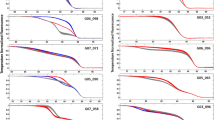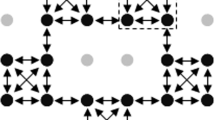Abstract
Red clover is a hermaphroditic allogamous diploid (2n = 2x = 14) with a homomorphic gametophytic self-incompatibility (GSI) system (Trifolium pratense L.). Red clover GSI has long been studied, and it is thought that the genetic control of GSI constitutes a single locus. Although GSI genes have been identified in other species, the genomic location of the red clover GSI-locus remains unknown. The objective of this study was to use a mapping-based approach to identify simple sequence repeats (SSR) that were closely linked to the GSI-locus. Previously published SSR markers were used in this effort (Sato et al. in DNA Res 12:301–364, 2005). A bi-parental cross was initiated in which the parents were known to have one self-incompatibility allele (S-allele) in common. S-allele genotypes of 100 progeny were determined through test crosses and pollen compatibility. Pseudo F1 linkage analysis isolated the GSI-locus on red clover linkage-group one within 2.5 cM of markers RCS5615, RCS0810, and RCS3161. A second 256 progeny mapping testcross population of a heterozygous self-compatible mutant revealed that this specific self-compatible mutant mapped to the same location as the GSI-locus. Finally, 82 genotypes were identified whose parents putatively shared one S-allele in common from maternal halfsib families derived from two random mating populations in which paternal identity was determined using molecular markers. Unique S-allele identity in the two random mating populations was tentatively inferred based on haplotypes of two highly allelic linkage-group one SSR (RCS0810 and RCS4956), which were closely linked to each other and the GSI-locus. Paternally derived pollen haplotype linkage analysis of RCS0810 and RCS4956 SSR and the GSI-locus again revealed tight linkage at 2.5 and 4.7 cM between the GSI-locus and RCS0810 and RCS4956, respectively. The map-based location of the GSI-locus in red clover has many immediate applications to red clover plant breeding and could be useful in helping to sequence the GSI-locus.



Similar content being viewed by others
References
Allen AM, Hiscock SJ (2008) Evolution and phylogeny of self-incompatibility systems in angiosperms. In: Franklin-Tong VE (ed) Self-incompatibility in flowering plants evolution, diversity, and mechanisms. Springer, Berlin, pp 73–101
Casey NM, Milbourne D, Barth S, Febrer M, Jenkins G, Abberton MT, Jones C, Thorogood D (2010) The genetic location of the self-incompatibility locus in white clover (Trifolium repens L.). Theor Appl Genet. doi:10.1007/s00122-010-1330-9
Castric V, Vekemans X (2004) Plant self-incompatibility in natural populations: a critical assessment of recent theoretical and empirical advances. Mol Ecol 13:2873–2889
Hill-Ambroz KL, Brown-Guedira GL, Fellers JP (2002) Modified rapid DNA extraction protocol for high throughput microsatellite analysis in wheat. Crop Sci 42:2088–2091
Kalinowski ST, Taper ML, Marshall TC (2007) Revising how the computer program CERVUS accommodates genotyping error increases success in paternity assignment. Mol Ecol 16:1006–1099
Kao T-H, Tsukamoto T (2004) The molecular and genetic basis of S-RNase-based self-incompatibility. Plant Cell 16(Suppl):S72–S83
Kosambi DD (1944) The estimation of map distance from recombination values. Ann Eugen 12:172–175
Lawrence MJ (1996) Number of incompatibility alleles in clover and other species. Heredity 76:610–615
Lawrence MJ (2000) Population genetics of the homomorphic self-incompatibility polymorphisms in flowering plants. Ann Bot 85:221–226
Maliepaard C, Jansen J, Van Ooijen JW (1997) Linkage analysis in a full-sib family of an outbreeding plant species: overview and consequences for applications. Genet Res 70:237–250
McClure BA (2004) S-RNase and SLF determine S-haplotype-specific pollen recognition and rejection. Plant Cell 16:2840–2847
Morton NE (1955) Sequential tests for the detection of linkage. Am J Hum Genet 7(3):277–318
Riday H (2007) Marker assisted selection in legumes. Lotus Newslett 137(3):102
Riday H (2010) Paternity testing, a poor man’s marker assisted breeding strategy to increase selection gains in outbred forage species. In: The 6th international symposium on the molecular breeding of forage and turf. Ediciones INTA, Buenos Aires, Argentina, p 119
Riday H, Krohn AL (2010) Increasing population hybridity by restricting self-incompatibility alleles in red clover populations. Crop Sci 50:853–860
Rinke EH, Johnson IJ (1941) Self-fertility in red clover in Minnesota. Agron J 33:512–521
Sato S, Isobe S, Asamizu E, Ohmido N, Kataoka R, Nakamura K, Kaneko T, Sakurai N, Okumura K, Klimenko I, Sasamoto S, Wada T, Watanabe A, Kohara M, Fujishiro T, Tabata S (2005) Comprehensive structural analysis of the genome of red clover (Trifolium pratense L.). DNA Res 12:301–364
Silow RA (1931) A preliminary report on pollen-tube growth in red clover (Trifolium pratense L.) Welsh. Plant Breed Stn Bull Ser H 12:228–233
Smith RR, Taylor NL, Bowley SR (1985) Red clover. In: Taylor NL (ed) Clover science and technology. ASA-CSSA-SSSA, Madison, pp 457–470
Steinbachs JE, Holsinger KE (2002) S-RNase-mediated gametophytic self-incompatibility is ancestral in Eudicots. Mol Boil Evol 19:825–829
Štorchová H, Hrdličková R, Chrtek J Jr, Tetera M, Fitze D, Fehrer J (2000) An improved method of DNA isolation from plants collected in the field and conserved in NaCl/CTAB solution. Taxon 49:79–84
Sturtevant AH (1913) The linear arrangement of six sex-linked factors in drosophila, as shown by their mode of association. J Exp Zoo 14:43–59
Taylor NL, Quesenberry KH (1996) Red clover science. Kluwer, Dordrecht
Townsend CE, Taylor NL (1985) Incompatibility and plant breeding. In: Taylor NL (ed) Clover science and technology. ASA-CSSA-SSSA, Madison, pp 365–381
Voorrips RE (2002) MapChart: Software for the graphical presentation of linkage maps and QTLs. J Hered 93(1):77–78
Williams RD, Silow RA (1933) Genetics of red clover (Trifolium pratense L.). Compatibility I. J Genet 27:341–362
Williams RD, Williams W (1947) Genetics of red clover (Trifolium pratense L.). Compatibility III. The frequency of incompatibility S alleles in two non-pedigree populations of red clover. J Genet 48:69–79
Wright S (1939) The distribution of self-sterility alleles in populations. Genetics 24:538–552
Zhang Y, Xue Y (2008) Molecular biology of S-RNase-based self-incompatibility. In: Franklin-Tong VE (ed) Self-incompatibility in flowering plants evolution, diversity, and mechanisms. Springer, Berlin, pp 193–215
Acknowledgments
We gratefully acknowledge the greenhouse and field technical support of Rebecca J. Heidelberger and technical lab support of Karolina Heyduk.
Author information
Authors and Affiliations
Corresponding author
Additional information
Communicated by Y. Xue.
Mention of trade names or commercial products in this publication is solely for the purpose of providing specific information and does not imply recommendation or endorsement by the US Department of Agriculture.
Rights and permissions
About this article
Cite this article
Riday, H., Krohn, A.L. Genetic map-based location of the red clover (Trifolium pratense L.) gametophytic self-incompatibility locus. Theor Appl Genet 121, 761–767 (2010). https://doi.org/10.1007/s00122-010-1347-0
Received:
Accepted:
Published:
Issue Date:
DOI: https://doi.org/10.1007/s00122-010-1347-0




